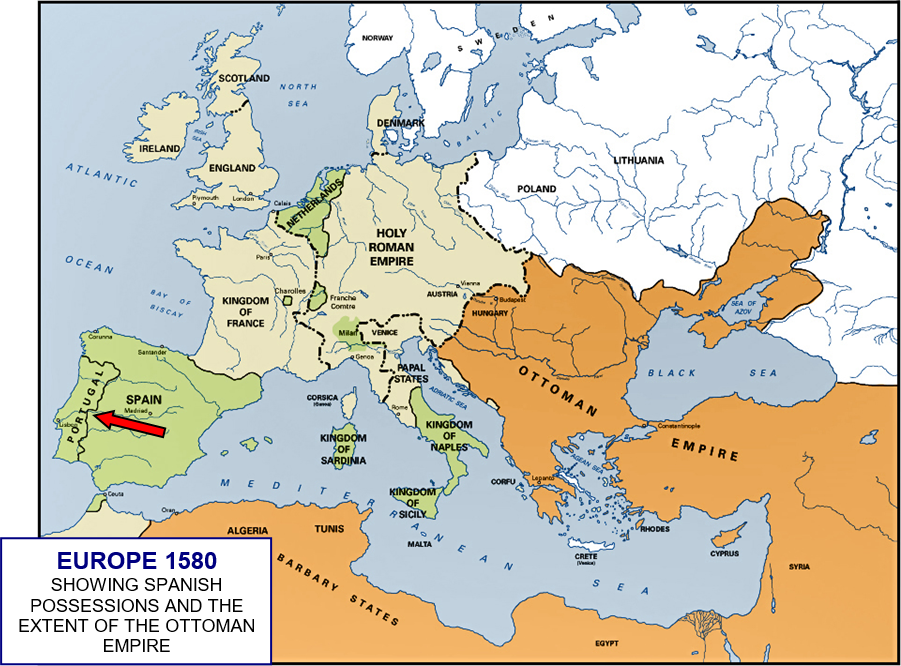


xxxxxIt was in 1139 (ST) that Afonso Henriques secured the independence of Portugal and, as we have seen, this was strengthened by the Treaty of Windsor, an alliance with England, in 1386. This enabled Henry the Navigator to embark on a programme of exploration. However, with the death of Henry the Cardinal King in 1580, putting an end to the Aviz dynasty, the major claimant to the throne, Philip II of Spain, invaded Portugal and gained control of the country by the Battle of Alcantara, near Lisbon. There followed the “Sixty Years’ Captivity”. Portuguese revolts in 1634 and 1637 failed, but in 1640 the Spanish were finally forced out. But it was not until 1668 (C2), by the Treaty of Lisbon, that Spain finally recognised Portugal’s independence.
THE BATTLE OF ALCANTARA 1580 (L1)
Acknowledgements
Alva: detail, by the Italian painter Titian (c1488-
xxxxxAs we have seen, it was in 1139 (ST) that Afonso Henriques, having defeated his mother at the battle of Sao Mamede and seized power, secured the independence of Portugal from the neighbouring Kingdom of Leon and assumed the title of King. By the time of his death in 1185 he had firmly established the new nation state. It was left to Afonso III to expel the Moors from the areas south of the Tagus, a task achieved by 1250. There followed a series of wars with the kingdom of Castile, but in 1385 John I defeated the Castilians at the Battle of Aljubarrota and, forming an alliance with England by the Treaty of Windsor (1386 R2), finally secured a period of peace. This enabled his son, Henry the Navigator, to embark on a programme of exploration which was to take the Portuguese along the west and east coasts of Africa, open the sea route to India and the East Indies, establish settlements in distant Brazil, and pioneer the slave trade from Africa to the New World.
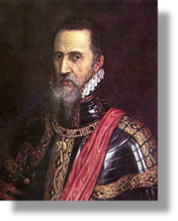
xxxxxWith the death of Henry the Cardinal King in 1580, however, the Aviz dynasty came to an end and no less than seven claimants disputed the succession. With Philip II of Spain as one of these claimants, the outcome was hardly in doubt. In August, Spanish forces under the command of the ruthless Duke of Alva (illustrated), invaded Portugal and defeated the supporters of Don Antonio at the Battle of Alcantara near Lisbon. Philip II was proclaimed king (as Philip I) and, at a stroke, Spain doubled her colonial empire and gained valuable harbours along the Atlantic seaboard.
xxxxxThere followed what came to be known as the "Sixty Years' Captivity". Under Philip's successors, Portugal became little more than a Spanish province. The lucrative trade with the East Indies was lost to the Dutch and English, parts of Brazil fell into Dutch hands, and the country was heavily taxed to help pay for Spain's defence of the Netherlands and its military designs upon England. In 1589 a large English expedition led by Sir Francis Drake and Sir John Norris attempted to place Dona Antonio on the Portuguese throne, but it failed to take Lisbon, and had to be abandoned. Widespread discontent against Spanish rule finally erupted, however, in 1634 and 1637. These uprisings proved unsuccessful, but in 1640 a national revolution, aided by the English, expelled the Spanish, and the Portuguese monarchy was restored. But, as we shall see, the war spluttered on, and it was not until the Treaty of Lisbon of 1668 (C2) that Spain finally recognised the country's regained independence.
xxxxxThe Spanish conquest of Portugal in 1580 (arrowed on map below), increasing as it did Spain's power and prestige throughout the world, greatly alarmed the rest of Europe, though, in fact, the potential it offered was hardly realised. As a result, both France and England gave increased support to the Dutch rebels within the Spanish Netherlands, seeing this as a means of engaging the "enemy" and confining his activities. As for Philip II, the next ten years or so was to see a decline, not an increase, in the might and majesty of Europe's most powerful state.
Including:
Philip II
of Spain

L1-
x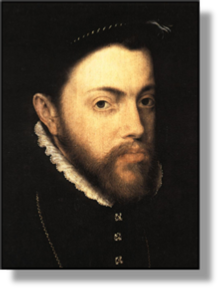 xxxxAs we have seen, Philip II (1527-
xxxxAs we have seen, Philip II (1527-
xxxxxPhilip’s reign began well with two decisive victories over the French, one at Saint Quentin in 1557, and the other at Gravelines the following year. These battles brought an end to a war which had raged on for some sixty years. By the Treaty of Cateau-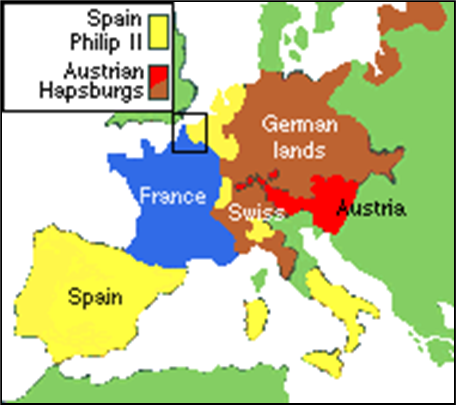 settlement, by the way, which confirmed England's surrender of Calais to the French). And later, too, in 1571, a naval force under the command of Philip's half brother, Don John of Austria, won a resounding victory over the Ottoman fleet at the Battle of Lepanto, thus removing for a time the almost constant threat posed by the Ottoman Turks in the eastern Mediterranean.
settlement, by the way, which confirmed England's surrender of Calais to the French). And later, too, in 1571, a naval force under the command of Philip's half brother, Don John of Austria, won a resounding victory over the Ottoman fleet at the Battle of Lepanto, thus removing for a time the almost constant threat posed by the Ottoman Turks in the eastern Mediterranean.
xxxxxBut it was a vast empire to control, and Philip was not really the man for the job. As an ardent Roman Catholic, the champion of the Counter Reformation, he was totally intolerant, seeing the Inquisition and the sword as the only means of solving the religious divide. As a result he drove the Dutch into a war of independence which occupied the cream of his army for over thirty years, and in 1588 he attempted an invasion of England which ended in the humiliating defeat of his "invincible" Armada. And within two years of this disaster he was again at war with France, supporting the Catholic forces of the Holy League in a costly and inconclusive war against Henry IV and his Protestants.
xxxxxHe fared somewhat better nearer home. He completed the work of unification begun by the monarchs Ferdinand and Isabella, and he prevented the growth of heresy in Spain and in his Italian possessions. However, his oppressive treatment of the Moriscos (those Muslims who had converted to Christianity) led to a bloody revolt in Granada in 1568, and the consequent expulsion of the Moorish population. Then in 1591 he was faced with a widespread rising amongst the Aragonese in defence of their local liberties.
xxxxxBut the greatest danger to the state was the ever-
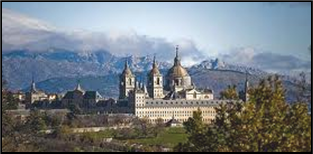 xxxxxPhilip's method of government did not help. He was hard-
xxxxxPhilip's method of government did not help. He was hard-
xxxxxPhilip II (1527-



